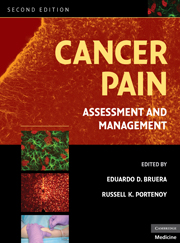Book contents
- Frontmatter
- Contents
- Contributors
- Preface
- SECTION I MECHANISMS AND EPIDEMIOLOGY
- SECTION II EPIDEMIOLOGY AND SYNDROMES
- SECTION III ASSESSMENT
- SECTION IV PHARMACOLOGICAL TREATMENT
- SECTION V OTHER INTERVENTIONAL STRATEGIES
- SECTION VI REHABILITATION AND PSYCHOLOGICAL INTERVENTIONS
- SECTION VII THE ROLE OF ANTINEOPLASTIC THERAPIES IN PAIN CONTROL
- SECTION VIII PAIN IN SPECIAL POPULATIONS
- SECTION IX DIFFICULT PAIN PROBLEMS
- 25 Cancer pain and depression
- 26 Neuropathic pain
- 27 Breakthrough pain
- 28 Bone pain
- SECTION X SYSTEMS OF CARE
- Index
- Plate section
- References
25 - Cancer pain and depression
from SECTION IX - DIFFICULT PAIN PROBLEMS
Published online by Cambridge University Press: 06 July 2010
- Frontmatter
- Contents
- Contributors
- Preface
- SECTION I MECHANISMS AND EPIDEMIOLOGY
- SECTION II EPIDEMIOLOGY AND SYNDROMES
- SECTION III ASSESSMENT
- SECTION IV PHARMACOLOGICAL TREATMENT
- SECTION V OTHER INTERVENTIONAL STRATEGIES
- SECTION VI REHABILITATION AND PSYCHOLOGICAL INTERVENTIONS
- SECTION VII THE ROLE OF ANTINEOPLASTIC THERAPIES IN PAIN CONTROL
- SECTION VIII PAIN IN SPECIAL POPULATIONS
- SECTION IX DIFFICULT PAIN PROBLEMS
- 25 Cancer pain and depression
- 26 Neuropathic pain
- 27 Breakthrough pain
- 28 Bone pain
- SECTION X SYSTEMS OF CARE
- Index
- Plate section
- References
Summary
Introduction
Effective management of pain in patients with advanced cancer may benefit from a multidisciplinary approach, enlisting expertise from a wide variety of clinical specialties, including neurology, neurosurgery, anesthesiology, and rehabilitation medicine. The use of psychiatric interventions in the treatment of cancer patients with pain also has become an integral part of such a comprehensive approach. This chapter reviews the assessment and management of one of the most common psychiatric disorders, depression, which has been shown to interact with and exacerbate pain among cancer patients.
Multidimensional concept of pain in cancer
Pain, especially in advanced cancer, is not a purely nociceptive or physical experience, but rather, it involves complex aspects of human functioning, including personality, affect, cognition, behavior, and social relations. Dame Cecily Saunders coined the term total pain to capture the all-encompassing nature of the suffering and discomfort that individuals with a terminal illness often experience. Given the conceptualization of pain as a multidimensional construct, it perhaps is not surprising that the use of analgesic drugs alone does not always lead to complete pain relief. As the interactions of cognitive, emotional, socioenvironmental, and nociceptive aspects of pain are difficult to separate, effective pain treatment often involves a multimodal intervention. Disentangling and addressing both the physical and the psychological issues underlying each patient's pain are essential to developing rational and successful management strategies. Applying psychosocial and somatic therapies in conjunction can lead to reciprocal effects.
- Type
- Chapter
- Information
- Cancer PainAssessment and Management, pp. 457 - 477Publisher: Cambridge University PressPrint publication year: 2009



